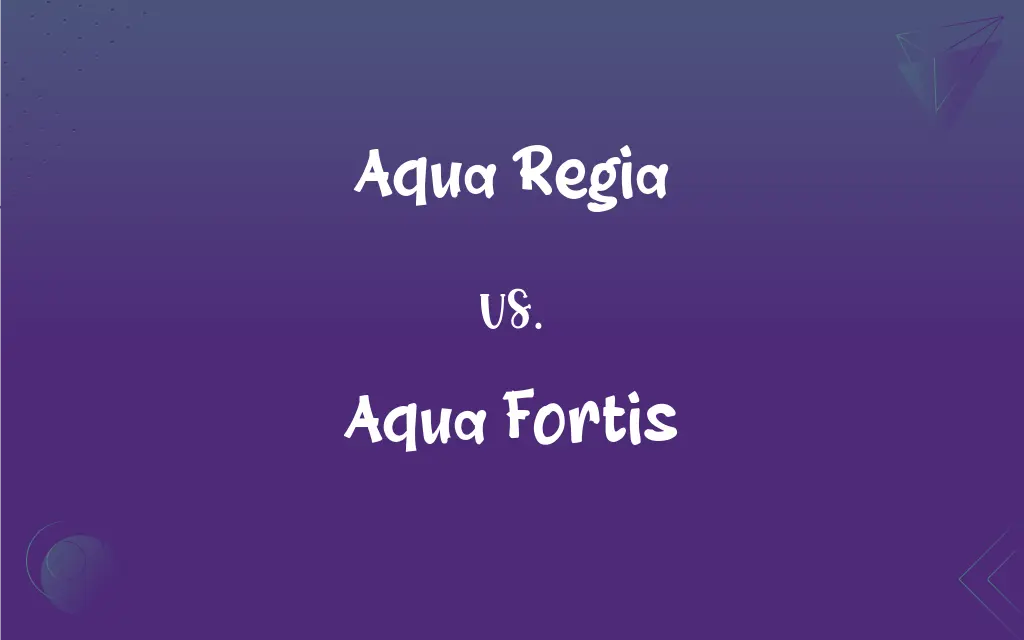Aqua Regia vs. Aqua Fortis: What's the Difference?
By Aimie Carlson & Harlon Moss || Published on March 25, 2024
Aqua regia, a mixture of nitric acid and hydrochloric acid, is capable of dissolving gold, while aqua fortis, pure nitric acid, is known for dissolving silver but not gold.

Key Differences
Aqua regia combines nitric acid (HNO3) and hydrochloric acid (HCl) in a roughly 1:3 ratio, creating a highly reactive solution capable of dissolving noble metals like gold and platinum. This ability stems from the formation of chloroauric acid when gold reacts with the mixture. Aqua fortis, or nitric acid, is a potent acid used in various industrial and chemical processes, including the purification of metals and the manufacturing of explosives. While aqua fortis can dissolve metals like silver, it cannot dissolve gold due to gold's resistance to oxidation by single acids.
The term "aqua regia" translates to "royal water" in Latin, named for its ability to dissolve "royal" metals that resist simpler acidic reactions. Aqua fortis, meaning "strong water," highlights the strength and corrosiveness of nitric acid. The unique chemical behavior of aqua regia, especially its ability to dissolve gold, has made it invaluable in metal refining and analytical chemistry, where it's used to prepare samples for analysis.
Aqua regia's effectiveness comes from the combined action of nitric acid and hydrochloric acid. Nitric acid acts as an oxidizing agent, forming gold ions, while hydrochloric acid provides chloride ions that react with gold ions to form chloroauric acid. In contrast, aqua fortis's action is limited to its properties as a strong oxidizing agent, making it suitable for dissolving less noble metals and preparing nitrates.
Safety and handling differ significantly between the two. Aqua regia is highly corrosive and volatile, requiring careful storage and handling to prevent accidents. Aqua fortis, while also dangerous, poses risks primarily related to its strong oxidizing properties and corrosiveness. Proper safety equipment and protocols are essential when working with either solution.
Understanding the differences between aqua regia and aqua fortis is crucial for their safe and effective use in chemical processes. Their distinct properties and applications underscore the importance of chemical knowledge in manipulating substances for desired reactions.
ADVERTISEMENT
Comparison Chart
Composition
Mixture of nitric acid and hydrochloric acid
Pure nitric acid
Ability to Dissolve Gold
Yes
No
Primary Use
Dissolving noble metals, refining gold
Dissolving metals like silver, manufacturing nitrates
Historical Significance
Known as "royal water" for its ability to dissolve gold and platinum
Called "strong water," used in alchemy and early chemistry
Safety Concerns
Highly corrosive and volatile, emits toxic gases
Corrosive, strong oxidizing agent, emits toxic fumes
ADVERTISEMENT
Aqua Regia and Aqua Fortis Definitions
Aqua Regia
Requires careful handling due to its corrosiveness.
When using aqua regia, wearing protective equipment is mandatory.
Aqua Fortis
Essential in the manufacture of explosives.
Nitric acid, or aqua fortis, is a key ingredient in making nitroglycerin.
Aqua Regia
Utilized in metal refining processes.
Refiners use aqua regia to recover gold from electronic scrap.
Aqua Fortis
Also poses safety risks due to its corrosiveness.
Handling aqua fortis requires gloves and eye protection due to its corrosive nature.
Aqua Regia
Composed of nitric acid and hydrochloric acid.
The chemist prepared aqua regia by mixing nitric and hydrochloric acids.
Aqua Fortis
Pure nitric acid used in various chemical processes.
Aqua fortis was historically used to separate silver from other metals.
Aqua Regia
Known for its potent reactivity.
Due to its reactivity, aqua regia can only be stored for short periods.
Aqua Fortis
Acts as a strong oxidizing agent.
Aqua fortis reacts with copper to produce copper nitrate and nitrogen dioxide.
Aqua Regia
A mixture capable of dissolving gold and platinum.
Aqua regia is used in laboratories to dissolve gold for purity testing.
Aqua Fortis
Can dissolve metals like silver but not gold.
Silver coins were dissolved in aqua fortis for chemical analysis.
FAQs
Can aqua fortis be used to make aqua regia?
Yes, aqua fortis (nitric acid) is one component of aqua regia and can be mixed with hydrochloric acid to create the mixture.
Why can aqua regia dissolve gold while aqua fortis cannot?
Aqua regia can dissolve gold because the combined action of nitric acid and hydrochloric acid creates a chemical environment that breaks down gold's resistance to corrosion, unlike aqua fortis, which lacks the necessary chloride ions.
What environmental considerations should be taken into account when disposing of aqua regia or aqua fortis?
Both acids should be neutralized and disposed of according to local environmental regulations to prevent harm to the environment or water sources, usually involving dilution, neutralization, and disposal in designated chemical waste facilities.
How does the concentration of acids in aqua regia affect its reactivity?
The reactivity of aqua regia depends on the concentration of its constituent acids; higher concentrations result in a more reactive solution capable of dissolving metals more quickly, but also pose greater safety risks.
How should aqua regia be stored?
Aqua regia should not be stored for long periods due to its tendency to decompose, releasing chlorine gas. It's best prepared fresh for each use.
How does the chemical industry utilize aqua fortis today?
Beyond metal processing, aqua fortis is used in the production of fertilizers, dyes, plastics, and the etching of metals in manufacturing processes.
Has the use of aqua regia and aqua fortis changed over time?
While their fundamental chemical properties remain the same, modern applications have evolved with advancements in science and technology, leading to more controlled and varied uses in chemical synthesis, metal recovery, and analytical chemistry.
Can aqua regia and aqua fortis be neutralized if spilled?
Yes, both can be neutralized with a weak base, such as sodium bicarbonate (baking soda), but it's crucial to do this carefully and with appropriate safety measures to avoid violent reactions.
What are the risks associated with the gases produced by aqua regia?
The gases produced by aqua regia, primarily chlorine and nitrogen dioxide, are highly toxic and corrosive, posing risks of respiratory irritation, lung damage, and environmental harm if not properly ventilated.
Are there any metals that neither aqua regia nor aqua fortis can dissolve?
Yes, certain metals and alloys, such as tantalum and iridium, are resistant to both aqua regia and aqua fortis due to their extremely low reactivity and strong resistance to corrosion.
What safety precautions are necessary when working with aqua regia and aqua fortis?
Working with either acid requires appropriate safety gear, including gloves, goggles, and a lab coat, in a well-ventilated area, along with proper chemical storage and waste disposal methods to prevent accidents and exposure.
How were aqua regia and aqua fortis discovered?
Both compounds have origins in alchemy and were discovered and used by alchemists in their quest to transform base metals into gold and in the search for the philosopher's stone, dating back to the Middle Ages.
Can aqua regia be used to recover platinum as well as gold?
Yes, aqua regia is capable of dissolving platinum, making it useful not only for gold recovery but also for refining and recovering platinum from various sources.
What historical significance does aqua regia hold in chemistry?
Aqua regia has a rich history in chemistry, notably used by alchemists in their efforts to dissolve noble metals, and in the modern era, it played a role in the discovery of elements and in Nobel Prize-related stories during World War II.
How can the effectiveness of aqua fortis in metal dissolution be enhanced?
The effectiveness of aqua fortis in dissolving metals can be enhanced by heating the solution or by adding certain catalysts that can facilitate the oxidation process, although these methods increase the risk of hazardous reactions.
How do the waste products of aqua regia and aqua fortis affect the environment?
The waste products, including heavy metals and acidic solutions, can be harmful to aquatic life, contaminate soil and water sources, and require careful disposal to minimize environmental impact.
Can aqua regia dissolve all precious metals?
While aqua regia can dissolve many precious metals, including gold and platinum, there are exceptions, and its effectiveness depends on the metal's reactivity and the conditions of the dissolution process.
What precautions are necessary for storing aqua fortis?
Aqua fortis should be stored in a cool, well-ventilated area away from organic materials and bases, in containers designed to resist its corrosive effects, and with proper labeling to ensure safety.
Are there any materials that can safely contain aqua regia?
Aqua regia should be stored in glass or certain types of plastic containers (such as polyethylene) that are resistant to its corrosive nature. Metal containers are not suitable due to the acid's ability to dissolve most metals.
What role does aqua fortis play in nitration reactions?
Aqua fortis is a key reagent in nitration reactions, where it is used to introduce nitro groups into organic molecules, a fundamental step in the manufacture of explosives and in organic synthesis.
About Author
Written by
Aimie CarlsonAimie Carlson, holding a master's degree in English literature, is a fervent English language enthusiast. She lends her writing talents to Difference Wiki, a prominent website that specializes in comparisons, offering readers insightful analyses that both captivate and inform.
Co-written by
Harlon MossHarlon is a seasoned quality moderator and accomplished content writer for Difference Wiki. An alumnus of the prestigious University of California, he earned his degree in Computer Science. Leveraging his academic background, Harlon brings a meticulous and informed perspective to his work, ensuring content accuracy and excellence.







































































